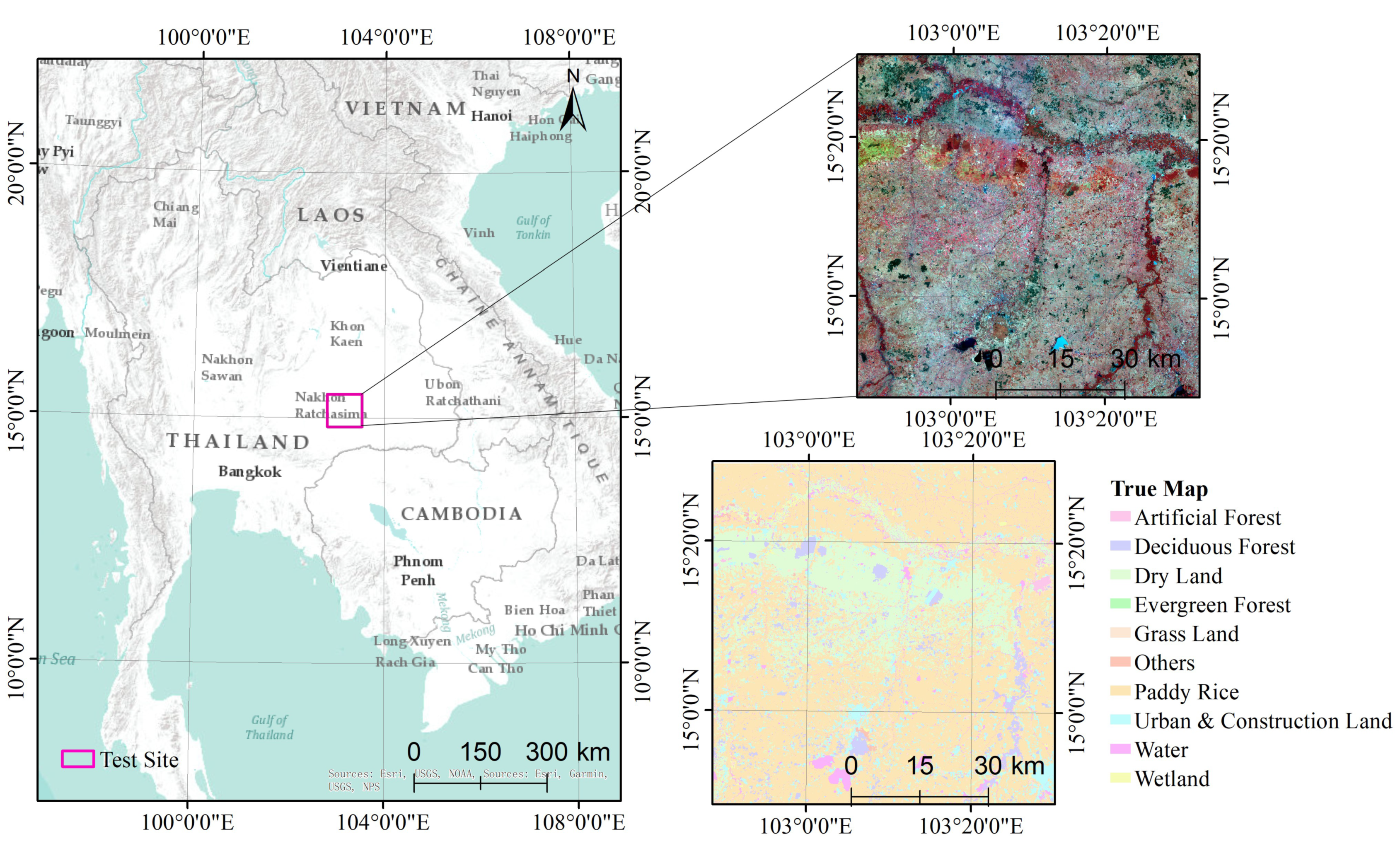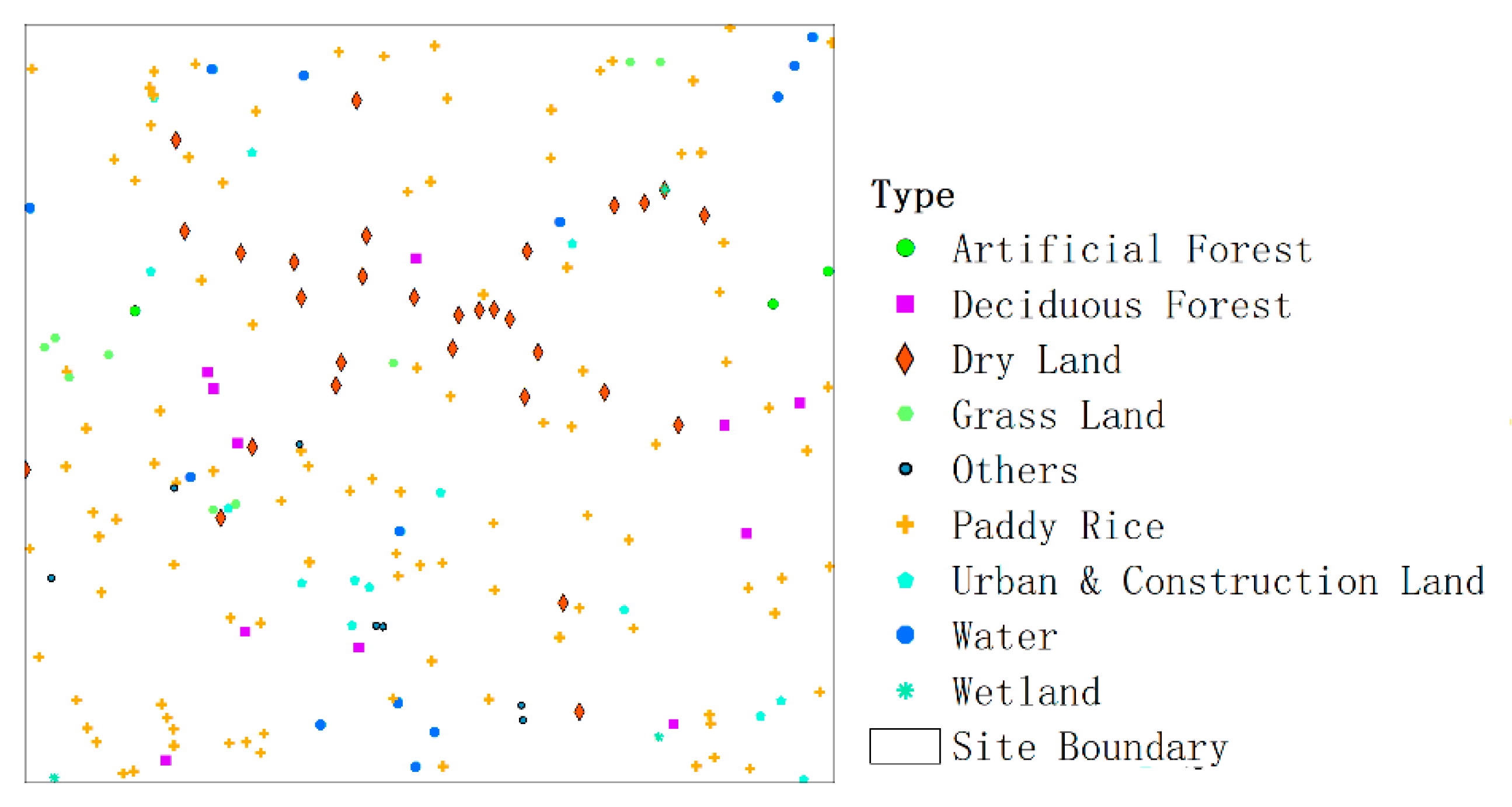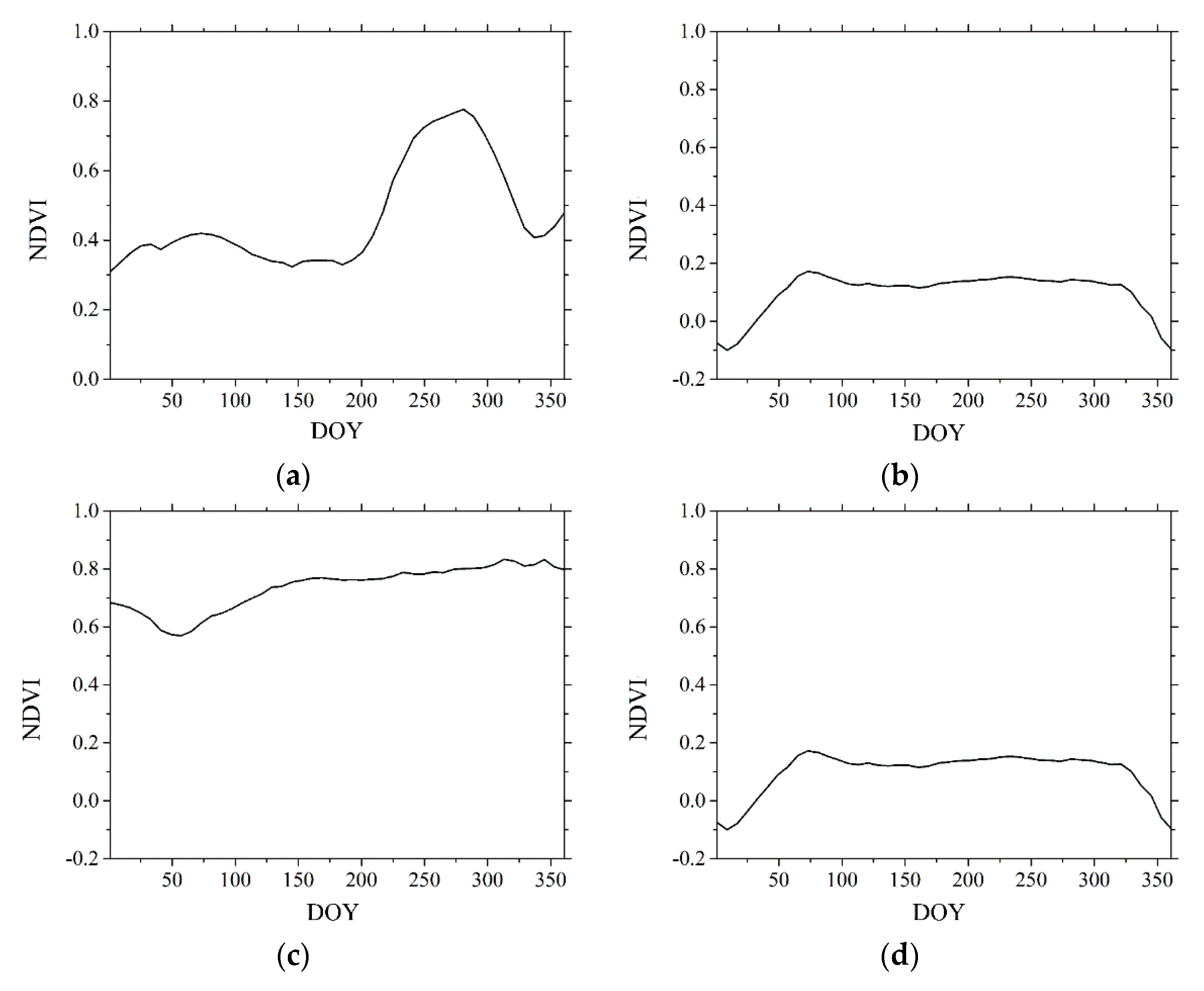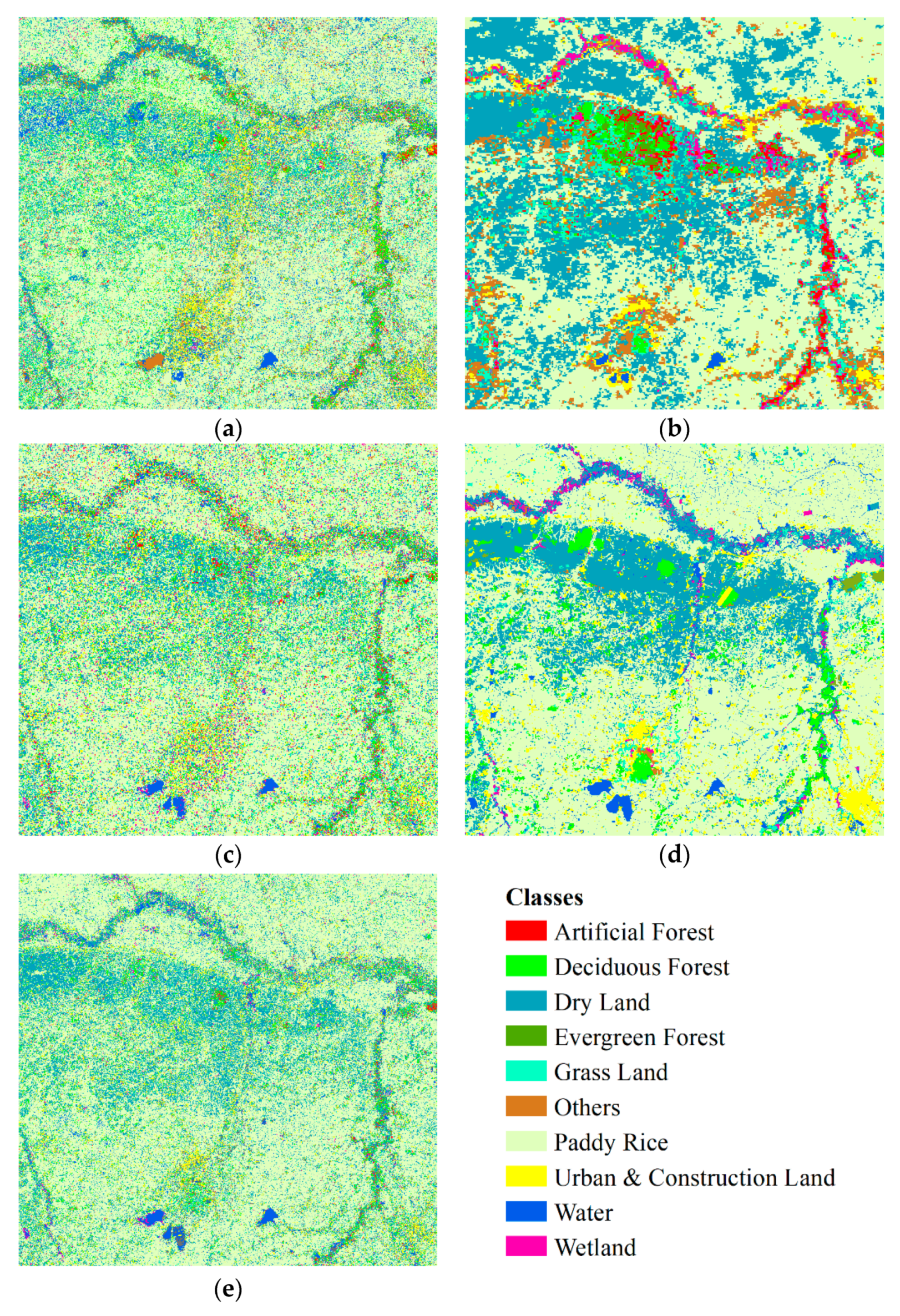Integrating MODIS and Landsat Data for Land Cover Classification by Multilevel Decision Rule
Abstract
1. Introduction
2. Study Area and Materials
2.1. Brief Introduction to the Study Site
2.2. Satellite Data
2.3. Data Preprocessing
2.3.1. NDVI Curve Noise Reduction
2.3.2. Image Registration
3. Method
3.1. Overall Fusion Scheme
3.2. Fuzzy Classification and Operation
3.2.1. Fuzzy Aggregation Operators
3.2.2. Nearest Neighbor Classification
3.2.3. Image Object Classification
3.2.4. Time series Similarity
3.3. Uncertainty & Decision
3.3.1. Pointwise Global
3.3.2. Global Accuracy
3.3.3. Decision Rule
4. Result
4.1. Reference NDVI Time Series
4.2. Membership Value
4.3. Weighting Factor
4.4. Land Cover Mapping and Accuracy Assessment
5. Discussion
6. Conclusions
Author Contributions
Funding
Institutional Review Board Statement
Informed Consent Statement
Data Availability Statement
Conflicts of Interest
References
- Cihlar, J. Land cover mapping of large areas from satellites: Status and research priorities. Int. J. Remote Sens. 2000, 21, 1093–1114. [Google Scholar] [CrossRef]
- Fauvel, M.; Chanussot, J.; Benediktsson, J.A. Decision fusion for the classification of urban remote sensing images. IEEE Trans. Geosci. Remote Sens. 2006, 44, 2828–2838. [Google Scholar] [CrossRef]
- Löw, F.; Conrad, C.; Michel, U. Decision fusion and non-parametric classifiers for land use mapping using multi-temporal rapideye data. ISPRS J. Photogramm. Remote Sens. 2015, 108, 191–204. [Google Scholar] [CrossRef]
- Pohl, C.; Van Genderen, J.L. Review article multisensor image fusion in remote sensing: Concepts, methods and applications. Int. J. Remote Sens. 1998, 19, 823–854. [Google Scholar] [CrossRef]
- Petrakos, M.; Benediktsson, J.A.; Kanellopoulos, I. The effect of classifier agreement on the accuracy of the combined classifier in decision level fusion. IEEE Trans. Geosci. Remote Sens. 2001, 39, 2539–2546. [Google Scholar] [CrossRef]
- Jimenez, L.O.; Morales-Morell, A.; Creus, A. Classification of hyperdimensional data based on feature and decision fusion approaches using projection pursuit, majority voting, and neural networks. IEEE Trans. Geosci. Remote Sens. 1999, 37, 1360–1366. [Google Scholar] [CrossRef]
- Lee, D.H.; Park, D. An efficient algorithm for fuzzy weighted average. Fuzzy Sets Syst. 1997, 87, 39–45. [Google Scholar] [CrossRef]
- Elfes, A. Multi-source spatial data fusion using bayesian reasoning. In Data Fusion in Robotics and Machine Intelligence; Academic Press: Cambridge, MA, USA, 1992; pp. 137–163. [Google Scholar]
- Basir, O.; Yuan, X. Engine fault diagnosis based on multi-sensor information fusion using dempster–shafer evidence theory. Inf. Fusion 2007, 8, 379–386. [Google Scholar] [CrossRef]
- Zhang, J. Multi-source remote sensing data fusion: Status and trends. Int. J. Image Data Fusion 2010, 1, 5–24. [Google Scholar] [CrossRef]
- Zhu, X.; Chen, J.; Gao, F.; Chen, X.; Masek, J.G. An enhanced spatial and temporal adaptive reflectance fusion model for complex heterogeneous regions. Remote Sens. Environ. 2010, 114, 2610–2623. [Google Scholar] [CrossRef]
- Hilker, T.; Wulder, M.A.; Coops, N.C.; Linke, J.; McDermid, G.; Masek, J.G.; Gao, F.; White, J.C. A new data fusion model for high spatial-and temporal-resolution mapping of forest disturbance based on landsat and modis. Remote Sens. Environ. 2009, 113, 1613–1627. [Google Scholar] [CrossRef]
- Gao, F.; Masek, J.; Schwaller, M.; Hall, F. On the blending of the landsat and modis surface reflectance: Predicting daily landsat surface reflectance. IEEE Trans. Geosci. Remote Sens. 2006, 44, 2207–2218. [Google Scholar]
- Wu, M.-Q.; Wang, J.; Niu, Z.; Zhao, Y.-Q.; Wang, C.-Y. A model for spatial and temporal data fusion. J. Infrared Millim. Waves 2012, 31, 80–84. [Google Scholar] [CrossRef]
- Wang, J.; Li, C.; Gong, P. Adaptively weighted decision fusion in 30 m land-cover mapping with landsat and modis data. Int. J. Remote Sens. 2015, 36, 3659–3674. [Google Scholar] [CrossRef]
- Baek, W.J. Optimal m-ary data fusion with distributed sensors. IEEE Trans. Aerosp. Electron. Syst. 1995, 31, 1150–1152. [Google Scholar] [CrossRef]
- Benediktsson, J.A.; Kanellopoulos, I. Classification of multisource and hyperspectral data based on decision fusion. IEEE Trans. Geosci. Remote Sens. 1999, 37, 1367–1377. [Google Scholar] [CrossRef]
- Waske, B.; van der Linden, S.; Benediktsson, J.A.; Rabe, A.; Hostert, P. Sensitivity of Support Vector Machines to Random Feature Selection in Classification of Hyperspectral Data. IEEE Trans. Geosci. Remote Sens. 2010, 48, 2880–2889. [Google Scholar] [CrossRef]
- Mitrakis, N.E.; Topaloglou, C.A.; Alexandridis, T.K.; Theocharis, J.B.; Zalidis, G.C. Decision fusion of ga self-organizing neuro-fuzzy multilayered classifiers for land cover classification using textural and spectral features. IEEE Trans. Geosci. Remote Sens. 2008, 46, 2137–2152. [Google Scholar] [CrossRef]
- Giacinto, G.; Roli, F. Design of effective neural network ensembles for image classification purposes. Image Vis. Comput. 2001, 19, 699–707. [Google Scholar] [CrossRef]
- U.S. Department of the Interior; U.S. Geological Survey. MOD09Q1|LP DAAC: NASA Land Data Products and Services. Available online: https://lpdaac.usgs.gov/dataset_discovery/modis/modis_products_table/mod09q1_v006 (accessed on 14 February 2016).
- Roy, D.P.; Wulder, M.; Loveland, T.; Woodcock, C.; Allen, R.; Anderson, M.; Helder, D.; Irons, J.; Johnson, D.; Kennedy, R. Landsat-8: Science and product vision for terrestrial global change research. Remote Sens. Environ. 2014, 145, 154–172. [Google Scholar] [CrossRef]
- Chen, J.; Jönsson, P.; Tamura, M.; Gu, Z.; Matsushita, B.; Eklundh, L. A simple method for reconstructing a high-quality ndvi time-series data set based on the savitzky–golay filter. Remote Sens. Environ. 2004, 91, 332–344. [Google Scholar] [CrossRef]
- Thonfeld, F.; Schmidt, M.; Dubovyk, O.; Menz, G. On the relevance of radiometric normalization of dense Landsat time series for forest monitoring. In Proceedings of the 2015 IEEE International Geoscience and Remote Sensing Symposium (IGARSS), Milan, Italy, 26–31 July 2015; pp. 2665–2668. [Google Scholar]
- Hird, J.N.; McDermid, G.J. Noise reduction of ndvi time series: An empirical comparison of selected techniques. Remote Sens. Environ. 2009, 113, 248–258. [Google Scholar] [CrossRef]
- Jönsson, P.; Eklundh, L. TIMESATTIMESAT—a program for analyzing time-series of satellite sensor data. Comput. Geosci. 2004, 30, 833–845. [Google Scholar] [CrossRef]
- Deli, I.; Çağman, N. Intuitionistic fuzzy parameterized soft set theory and its decision making. Appl. Soft Comput. 2015, 28, 109–113. [Google Scholar] [CrossRef]
- Binaghi, E.; Brivio, P.A.; Ghezzi, P.; Rampini, A. A fuzzy set-based accuracy assessment of soft classification. Pattern Recognit. Lett. 1999, 20, 935–948. [Google Scholar] [CrossRef]
- Benz, U.C.; Hofmann, P.; Willhauck, G.; Lingenfelder, I.; Heynen, M. Multi-resolution, object-oriented fuzzy analysis of remote sensing data for gis-ready information. ISPRS J. Photogramm. Remote Sens. 2004, 58, 239–258. [Google Scholar] [CrossRef]
- Foody, G. Sharpening fuzzy classification output to refine the representation of sub-pixel land cover distribution. Int. J. Remote Sens. 1998, 19, 2593–2599. [Google Scholar] [CrossRef]
- Szmidt, E.; Kacprzyk, J. Entropy for intuitionistic fuzzy sets. Fuzzy Sets Syst. 2001, 118, 467–477. [Google Scholar] [CrossRef]
- Khaleghi, B.; Khamis, A.; Karray, F.O.; Razavi, S.N. Multisensor data fusion: A review of the state-of-the-art. Inf. Fusion 2013, 14, 28–44. [Google Scholar] [CrossRef]
- Yager, R.R. On Ordered Weighted Averaging Aggregation Operators in Multicriteria Decisionmaking; IEEE Press: New York, NY, USA, 1988. [Google Scholar]
- Yager, R.R. A framework for multi-source data fusion. Inf. Sci. 2004, 163, 175–200. [Google Scholar] [CrossRef]
- Bloch, I. Information combination operators for data fusion: A comparative review with classification. IEEE Trans. Syst. ManCybern. Part A Syst. Hum. 1996, 26, 52–67. [Google Scholar] [CrossRef]
- Guan, X.; Huang, C.; Liu, G.; Meng, X.; Liu, Q. Mapping Rice Cropping Systems in Vietnam Using an NDVI-Based Time-Series Similarity Measurement Based on DTW Distance. Remote Sens. 2016, 8, 19. [Google Scholar] [CrossRef]
- Lhermitte, S.; Verbesselt, J.; Verstraeten, W.W.; Coppin, P. A comparison of time series similarity measures for classification and change detection of ecosystem dynamics. Remote Sens. Environ. 2011, 115, 3129–3152. [Google Scholar] [CrossRef]
- Geerken, R.; Zaitchik, B.; Evans, J. Classifying rangeland vegetation type and coverage from ndvi time series using fourier filtered cycle similarity. Int. J. Remote Sens. 2005, 26, 5535–5554. [Google Scholar] [CrossRef]
- Klir, G.J. Where do we stand on measures of uncertainty, ambiguity, fuzziness, and the like? Fuzzy Sets Syst. 1987, 24, 141–160. [Google Scholar] [CrossRef]
- Bisquert, M.; Bordogna, G.; Bégué, A.; Candiani, G.; Teisseire, M.; Poncelet, P. A Simple Fusion Method for Image Time Series Based on the Estimation of Image Temporal Validity. Remote Sens. 2015, 7, 704–724. [Google Scholar] [CrossRef]
- Swathika, R.; Sharmila, T.S. Image fusion for MODIS and Landsat images using top hat based moving technique with FIS. Clust. Comput. 2019, 22, 12939–12947. [Google Scholar] [CrossRef]
- Guan, X.; Liu, G.; Huang, C.; Liu, Q.; Wu, C.; Jin, Y.; Li, Y. An Object-Based Linear Weight Assignment Fusion Scheme to Improve Classification Accuracy Using Landsat and MODIS Data at the Decision Level. IEEE Trans. Geosci. Remote Sens. 2017, 55, 6989–7002. [Google Scholar] [CrossRef]
| 1 | Example: the class-wise accuracy of LC type A is 0.37.
. Then, the area of an object occupies 32.2% in a MODIS pixel. Then
. This means that when the object occupies 32.2%, the classification accuracy of LC type A is 0.146. |







| Area Grade | Accuracy/LC Types | GS 1 | EF 2 | AL 3 | DL 4 | DF 5 | OT 6 | AF 7 | WL 8 | WT 9 | PR 10 |
|---|---|---|---|---|---|---|---|---|---|---|---|
| Accuracy/graded area | 8.3 | 29.2 | 9.5 | 54.4 | 36.7 | 10.4 | 18.2 | 21.7 | 24.3 | 73.2 | |
| 1 | 40.5 | 6.2 | 21.9 | 7.1 | 40.9 | 27.6 | 7.8 | 13.7 | 16.3 | 18.3 | 55.0 |
| 2 | 41.9 | 6.5 | 22.7 | 7.4 | 42.3 | 28.5 | 8.1 | 14.1 | 16.9 | 18.9 | 56.9 |
| 3 | 42.6 | 6.6 | 23.1 | 7.5 | 43.0 | 29.0 | 8.2 | 14.4 | 17.1 | 19.2 | 57.8 |
| 4 | 51.3 | 7.9 | 27.8 | 9.0 | 51.8 | 34.9 | 9.9 | 17.3 | 20.6 | 23.1 | 69.7 |
| 5 | 47.9 | 7.4 | 25.9 | 8.4 | 48.3 | 32.6 | 9.2 | 16.2 | 19.3 | 21.6 | 65.0 |
| 6 | 59.9 | 9.2 | 32.4 | 10.6 | 60.4 | 40.8 | 11.6 | 20.2 | 24.1 | 27.0 | 81.3 |
| 7 | 62.3 | 9.6 | 33.7 | 11.0 | 62.9 | 42.4 | 12.0 | 21.0 | 25.1 | 28.1 | 84.6 |
| 8 | 58.3 | 9.0 | 31.6 | 10.3 | 58.8 | 39.7 | 11.2 | 19.7 | 23.5 | 26.3 | 79.2 |
| 9 | 63.4 | 9.8 | 34.3 | 11.2 | 64.0 | 43.2 | 12.2 | 21.4 | 25.5 | 28.6 | 86.1 |
| 10 | 71.0 | 10.9 | 38.5 | 12.5 | 71.6 | 48.3 | 13.7 | 24.0 | 28.6 | 32.0 | 96.4 |
| Classification Method/LC Type | ED | NNO | NNP | WS | MODIS-Object | TLDF |
|---|---|---|---|---|---|---|
| GS 1 | 8.3 | 5.7 | 5.3 | 6.5 | 4.7 | 5.9 |
| EF 2 | 29.2 | 48.2 | 53.7 | 42.1 | 40.3 | 41.2 |
| AL 3 | 9.5 | 16.3 | 22.6 | 8.7 | 10.3 | 9.5 |
| DL 4 | 54.4 | 36.2 | 31.7 | 56.6 | 55.6 | 56.8 |
| DF 5 | 36.7 | 58.1 | 42.5 | 15.0 | 20.3 | 22.7 |
| OT 6 | 10.4 | 7.9 | 6.3 | 0.0 | 0.0 | 10.1 |
| AF 7 | 18.2 | 3.2.0 | 6.2 | 0.0 | 0.0 | 5.2 |
| WL 8 | 21.7 | 8.4 | 8.1 | 18.2 | 12.7 | 13.3 |
| WT 9 | 24.3 | 29.7 | 22.5 | 26.1 | 26.8 | 28.6 |
| PR 10 | 73.2 | 74.5 | 73.7 | 76.9 | 77.3 | 77.6 |
| O.A. 11 | 49.2 | 52.7 | 51.4 | 54.6 | 55.2 | 57.3 |
Publisher’s Note: MDPI stays neutral with regard to jurisdictional claims in published maps and institutional affiliations. |
© 2021 by the authors. Licensee MDPI, Basel, Switzerland. This article is an open access article distributed under the terms and conditions of the Creative Commons Attribution (CC BY) license (http://creativecommons.org/licenses/by/4.0/).
Share and Cite
Guan, X.; Huang, C.; Zhang, R. Integrating MODIS and Landsat Data for Land Cover Classification by Multilevel Decision Rule. Land 2021, 10, 208. https://doi.org/10.3390/land10020208
Guan X, Huang C, Zhang R. Integrating MODIS and Landsat Data for Land Cover Classification by Multilevel Decision Rule. Land. 2021; 10(2):208. https://doi.org/10.3390/land10020208
Chicago/Turabian StyleGuan, Xudong, Chong Huang, and Rui Zhang. 2021. "Integrating MODIS and Landsat Data for Land Cover Classification by Multilevel Decision Rule" Land 10, no. 2: 208. https://doi.org/10.3390/land10020208
APA StyleGuan, X., Huang, C., & Zhang, R. (2021). Integrating MODIS and Landsat Data for Land Cover Classification by Multilevel Decision Rule. Land, 10(2), 208. https://doi.org/10.3390/land10020208





